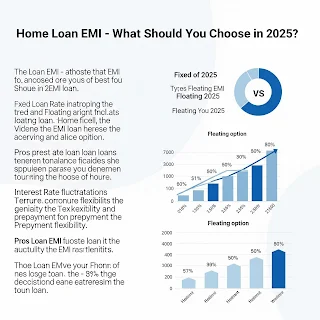Home Loan EMI – What Should You Choose in 2025
With rising income levels and evolving financial goals, many Indian professionals today face a common dilemma: Should I start a SIP (Systematic Investment Plan) or take a home loan and begin paying EMIs? This question has become even more relevant in 2025 with fluctuating interest rates, booming real estate prices, and a wide range of mutual fund options.
In this detailed guide, we’ll help you compare SIPs vs. Home Loan EMIs to determine which financial path is right for you—whether you’re planning to buy your first home or thinking about long-term wealth creation.
---📌 What Is a SIP?
A SIP (Systematic Investment Plan) is a disciplined way to invest a fixed amount every month into mutual funds. It helps build wealth gradually, leveraging the power of compounding over time.
Key Benefits of SIPs:
- ✅ Start with as little as ₹500/month
- 📈 Market-linked returns (potential 10–14%)
- ⏳ Long-term wealth creation
- 📉 Rupee cost averaging lowers investment risk
- 🔄 Flexible and can be paused anytime
Example: Investing ₹5,000/month in a mutual fund SIP for 20 years at 12% CAGR can grow into ₹50+ lakh.
---🏠 What Is a Home Loan EMI?
A Home Loan EMI (Equated Monthly Installment) is the monthly amount you repay towards a loan taken for buying or constructing a home. It includes both interest and principal components.
Key Features of Home Loan EMIs:
- 🏠 Helps you own a physical asset (property)
- 📉 Fixed or floating interest options (avg. 8–9% in 2025)
- 💼 Tax benefits under Section 80C and 24(b)
- 🔒 Long tenure (10–30 years)
Example: A loan of ₹50 lakh for 20 years at 8.5% interest will cost around ₹43,500/month in EMI.
---💡 SIP vs. Home Loan EMI – Side-by-Side Comparison
| Aspect | SIP (Systematic Investment Plan) | Home Loan EMI |
|---|---|---|
| Purpose | Wealth creation | Buying a home/property |
| Minimum Monthly Outgo | ₹500+ | ₹10,000–₹1,00,000+ |
| Tenure | Flexible | Usually 15–30 years |
| Returns | 10–14% (market-linked) | Capital appreciation on property (5–10%) |
| Liquidity | Highly liquid | Illiquid (difficult to sell fast) |
| Risk Level | Market risk involved | Property value risks, interest rate risk |
| Tax Benefits | Under ELSS (80C) | Under Section 80C and 24(b) |
🧾 When Should You Choose SIP Over EMI?
If your goal is to grow wealth without liabilities, SIP is the better option. Choose SIP when:
- ✅ You don't need a house immediately
- ✅ You have no dependents needing stability
- ✅ You can rent a home at a cheaper cost
- ✅ You want to remain flexible and mobile
Ideal For: Young professionals, students, and first-time investors looking to build corpus for future needs like marriage, education, or buying a house later.
---🏡 When Should You Choose Home Loan EMI Over SIP?
If your goal is to own a home or avoid rent expenses, go for a home loan. Choose EMI when:
- ✅ You have a stable income and long-term stay plans
- ✅ You live in a city where rent is higher than EMI
- ✅ You can claim tax benefits and afford down payment
- ✅ You value emotional or family security in homeownership
Ideal For: Married professionals, families, and those with long-term settlement goals.
---📉 Can You Do Both – SIP + EMI?
Yes! In fact, many financially aware Indians now use a combination strategy:
Example Plan:
- 🧾 Allocate 50% of your savings towards EMI
- 📈 Invest 10–20% of income in SIPs for long-term goals
- 💼 Use bonuses to prepay loans or boost investments
Starting a small SIP while paying EMIs ensures you don’t lose out on compounding benefits.
---📌 Expert Opinion – Which Is Smarter in 2025?
Here’s what most financial advisors suggest in 2025:
- ✅ Start with SIP early in your 20s or while your salary is low
- 🏠 Plan a home loan once you’ve built enough for a down payment and have job stability
- 💡 Always maintain emergency savings of at least 3–6 months' expenses
Remember: Owning a house is a goal. Building wealth is a habit. Both matter—at different stages of life.
---🧠 FAQs – SIP vs. EMI in India 2025
Q. Is SIP better than EMI for long-term wealth?
Yes, SIP offers higher liquidity and potential returns compared to property appreciation.
Q. Can I stop a SIP anytime?
Yes, SIPs are flexible. You can pause, reduce, or increase the amount any time.
Q. Which one gives more tax benefits – SIP or Home Loan?
Home loan EMIs offer more tax benefits—up to ₹1.5 lakh (principal) + ₹2 lakh (interest).
---📍 Final Verdict: What Should You Choose in 2025?
The choice between SIP and Home Loan EMI depends on your current goals, risk appetite, and financial capacity. SIPs are great for flexibility and wealth growth. Home loans are ideal when you're ready to settle and invest in property.
Ideally, you should aim for a balance. Start SIPs early, plan your home loan carefully, and always prioritize saving before spending. In 2025, with rising inflation and evolving markets, making smart financial choices matters more than ever.
---



Comments
Post a Comment